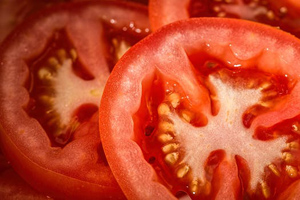
By Libby James
The season of the tomato is upon us. This popular fruit that masquerades as a vegetable, will soon be ripening in home gardens all over the place. The basis for soups, sauces, and an essential for a “BLT,” the tomato as we know it was probably developed in Mexico. It has hundreds of wild tomato relatives including a species found in the Galapagos Islands off Ecuador.
In the early 1900s, tomatoes were considered poisonous by some, who feared they contained the same toxic alkaloids as other members of the nightshade family — of which they are a part.
Charley Rick, a tomato geneticist who was a member of the vegetable crops department at UC Davis, spent most of his life researching tomatoes. After a trip to the Galapagos Islands, he was puzzled by the fact that he could not get the wild tomato seeds he brought back to his laboratory to grow. His plan was to germinate and grow the seeds for research purposes. After pondering what was present in the place where he had gathered the seeds but not in his laboratory, he hit upon a possibility. Could the tortoises, so prevalent in the Galapagos islands, play a role in germinating the tomato seeds?
He went searching for a tortoise in California, brought it to his laboratory, and fed it the wild tomato seeds. Eureka! They grew once they had been processed through the tortoise’s digestive system. Over time, Rick was able to crossbreed the wild tomato seeds with domestic seeds, eventually resulting in tomato varieties that are sweeter, need less water, get fewer diseases, and attract fewer insects. Tomato growers, from home gardeners to large scale tomato farmers, owe him a debt of gratitude.
The first known tomatoes grew high in the Andes Mountains in South America. Travelers carried them to Mexico, and in the 1500s European explorers discovered them there and took them home. Italians became especially fond of them, calling them “love apples” and eating them with oil, salt, and pepper.
Rick studied tomatoes over a career that lasted for 60 years, eventually collecting 900 varieties of tomato seeds and creating a seed bank used by scientists from all over the world. He was elected to the National Academy of Science, wrote 150 research papers, and was a popular speaker on the subject at many universities.
Where would we be without the tomato?
Support Northern Colorado Journalism
Show your support for North Forty News by helping us produce more content. It's a kind and simple gesture that will help us continue to bring more content to you.
BONUS - Donors get a link in their receipt to sign up for our once-per-week instant text messaging alert. Get your e-copy of North Forty News the moment it is released!
Click to Donate